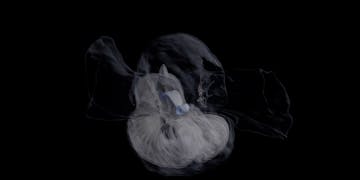Living in an essentially zero-gravity environment, many gelatinous deep-sea animals create elaborate filters made of mucus to collect food from their surroundings. Now, a unique laser-based system developed at MBARI has made it possible to create detailed models of these delicate structures and the animals that build them, helping shed light on another deep-sea mystery.
Mucus is ubiquitous in the ocean. Many animals build complex mucous structures for feeding, health, and protection. But by its nature, mucus is slippery, flimsy, and falls apart when collected or removed from the water, so it’s been difficult to study these structures. The new laser-based technology helps researchers better understand how mucous structures function and their roles in the ocean.
MBARI Principal Engineer Kakani Katija and her team focused their initial laser studies on one of the most prolific mucus architects, deep-sea animals called larvaceans. Larvaceans are abundant throughout the world’s ocean basins and range from less than one centimeter to about 10 centimeters in length (half an inch to four inches). The largest of these animals create balloon-like mucous webs that can be up to a meter (about three feet) across. The web includes different layers of filters, from the larger outer filters to the fist-sized inner filters that the animals use to feed on tiny particles and organisms.

Despite their insubstantial bodies, larvaceans remove vast amounts of carbon-rich food out of the surrounding water. When their mucous filters become clogged, the animals release the entire filter, which sinks rapidly to the seafloor. The result is that carbon dioxide absorbed from the atmosphere, and microplastics floating in the water column, are transported down to the seafloor. MBARI Senior Scientist Bruce Robison, who has studied the midwater’s gelatinous animals for decades, has long been interested in how larvaceans can filter a wide variety of particles while processing very large volumes of water (up to 80 liters, or 21 gallons, an hour). Previous studies have looked at smaller larvacean filters in the laboratory, but this is the first study to provide quantitative data about these mucous structures in the ocean.

To gather these data, Katija and her team in MBARI’s Bioinspiration Lab worked with engineers, scientists, and remotely operated vehicle (ROV) pilots to develop an instrument called DeepPIV (PIV stands for particle imaging velocimetry). Mounted on an ROV, the DeepPIV instrument projects a sheet of laser light that illuminates particles in the water, like dust motes in a sunbeam. By recording the movement of these particles in a video, researchers can quantify tiny currents around marine animals as well as water flowing through their filters and their transparent bodies. During field deployments of the DeepPIV system, Katija and her colleagues discovered that, as the ROV moved back and forth, the sheet of laser light revealed a series of cross sections through the transparent, gelatinous bodies and the mucous filters of giant larvaceans. By assembling a series of these cross-sectional images, the team created three-dimensional reconstructions of individual larvaceans and their filters, much as radiologists do following a CAT scan of a human body.
Collecting high-fidelity video imagery required skilled piloting of the ROVs. Knute Brekke, chief pilot for the ROV Doc Ricketts, commented that collecting these three-dimensional cross sections was probably the hardest thing he’d ever done with an ROV. It is not often that the pilots need to carefully fly the 5,400-kilogram (11,900-pound) vehicle to move a millimeter-thick laser sheet back and forth through a larvacean and its mucous filter—all while the animal is drifting in the ocean current.

Combining three-dimensional models of larvacean filters with observations of flow patterns through the filters, Katija and her collaborators were able, for the first time, to identify the shape and function of different parts of the larvacean’s inner filter. Using 3D rendering software, they could virtually “fly through” the inner filter and study the flow of fluid and particles through different parts of the filter.
The team is hoping to understand how larvaceans build and inflate these structures. Katija sees possible applications of this knowledge to such varied uses as designing better 3D printers or building complex inflatable structures that could be used underwater or in outer space. Expanding on this work, members of the Bioinspiration Lab are experimenting with new 3D imaging systems that capture highly precise information about the intensity, color, and direction of light in a scene. They are also collaborating on the development of new underwater robots that will be able to follow gelatinous animals through the water for hours or days at a time.
Katija and her team published a description of this new laser system and the resulting data in the journal Nature. News of this fascinating development was then picked up by at least 20 major news organizations, including CBS This Morning.
This new laser imaging system has been proven to work mounted on different vehicles and study different midwater organisms. Katija commented, “Now that we have a tool to study the mucous filtering systems found throughout the ocean, we can finally bring to light some of nature’s most complex structures.”
This video is a first-of-its-kind three-dimensional reconstruction made in collaboration with the Digital Life Project at the University of Massachusetts. Using 3D rendering software, they were able to create this video to virtually "fly through" a larvacean’s inner filter and study the flow of fluid and particles through different parts. This technology will allow researchers to study mucous structures throughout the ocean, which are some of the most complex forms that can be found in nature.
